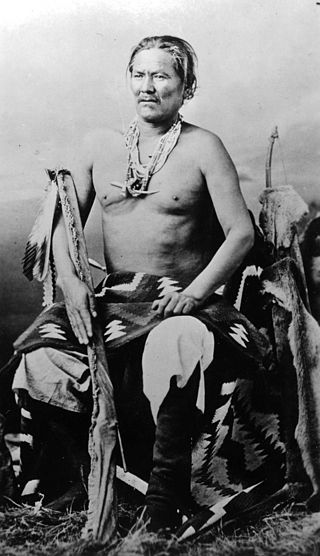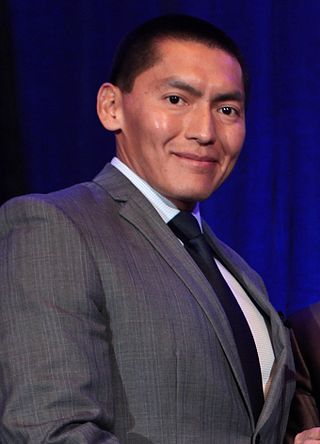Related Research Articles

The Navajo Nation, also known as Navajoland, is a Native American reservation of Navajo people in the United States. It occupies portions of northeastern Arizona, northwestern New Mexico, and southeastern Utah. The seat of government is located in Window Rock, Arizona.

Diné College is a public tribal land-grant college based in Tsaile, Arizona, serving the 27,000-square-mile (70,000 km2) Navajo Nation. It offers associate degrees, bachelor's degrees, and academic certificates.

Annie Dodge Wauneka was an influential member of the Navajo Nation as member of the Navajo Nation Council. As a member and three term head of the council's Health and Welfare Committee, she worked to improve the health and education of the Navajo. Wauneka is widely known for her countless efforts to improve health on the Navajo Nation, focusing mostly on the eradication of tuberculosis within her nation. She also authored a dictionary, in which translated English medical terms into the Navajo language. She was awarded the Presidential Medal of Freedom in 1963 by Lyndon B. Johnson as well as the Indian Council Fire Achievement Award and the Navajo Medal of Honor. She also received an honorary doctorate in Humanities from the University of New Mexico. In 2000, Wauneka was inducted into the National Women's Hall of Fame.

The Navajo are a Native American people of the Southwestern United States.
Anna Lee Walters is a Pawnee/Otoe–Missouria author.
Elizabeth Woody is an American Navajo/Warm Springs/Wasco/Yakama artist, author, and educator. In March 2016, she was the first Native American to be named poet laureate of Oregon by Governor Kate Brown.

Harrison Begay, also known as Haashké yah Níyá was a renowned Diné (Navajo) painter, printmaker, and illustrator. Begay specialized in watercolors, gouache, and silkscreen prints. At the time of his death in 2012, he was the last living, former student of Dorothy Dunn and Geronima C. Montoya at the Santa Fe Indian School. His work has won multiple awards and is exhibited in museums and private collections worldwide and he was among the most famous Diné artists of his generation.

The Bureau of Indian Education (BIE), headquartered in the Main Interior Building in Washington, D.C., and formerly known as the Office of Indian Education Programs (OIEP), is a division of the U.S. Department of the Interior under the Assistant Secretary for Indian Affairs. It is responsible for the line direction and management of all BIE education functions, including the formation of policies and procedures, the supervision of all program activities, and the approval of the expenditure of funds appropriated for BIE education functions.
Evelyne E. Bradley was an American Navajo judge. She served as a district judge for the Navajo Nation from 1984 until her retirement in 1995. Bradley was one of the first women to become a judge within the Navajo Nation.
Jennifer Nez Denetdale is a professor of American studies at the University of New Mexico, where she teaches courses in Native American Studies with an emphasis on race, class, and gender. She is the director of the University of New Mexico's Institute for American Research. She also specializes in Navajo history and culture and the effects of colonization and decolonization as it has impacted the Navajo people. She is the chair of the Navajo Nation Human Rights Commission. Denetdale is also an advocate for students who wish to pursue an education in Indigenous studies, Navajo women, and the LGBTQ+ community.
Tom B.K. Goldtooth is a Native American environmental, climate, and economic justice activist, speaker, film producer, and Indigenous rights leader. He is active in local, national and international levels as an advocate for building healthy and sustainable Indigenous communities based upon the foundation of Indigenous traditional knowledge. Goldtooth has served as executive director of the Indigenous Environmental Network (IEN) since 1996 after serving as a member of the IEN National Council since 1992.

Carlyle W. Begay is a Diné-American politician. A member of the Republican Party, he represented the seventh district in the Arizona State Senate which is the largest Legislative State District in the Continental United States.

Iva Casuse Honwynum is a Hopi/Navajo artist, social activist, and cultural practitioner. A Native American, Honwynum is best known for her woven baskets and figurative sculpture. Honwynum's most important breakthrough was the development of the pootsaya basket, called "a rare innovation in Hopi basketry". She developed the pootsaya during her 2014 residency at the School for Advanced Research in Santa Fe, New Mexico, having been awarded the Eric and Barbara Dookin Artist Fellowship.
Maggie L. George is an American academic administrator and educator. She served as president of Diné College from August 2011 to January 2016. In 2006, George became the inaugural director of academic affairs and Indian education for the New Mexico Higher Education Department.
Melissa Cody is a Navajo textile artist from No Water Mesa, Arizona, United States. Her Germantown Revival style weavings are known for their bold colors and intricate three dimensional patterns. Cody maintains aspects of traditional Navajo tapestries, but also adds her own elements into her work. These elements range from personal tributes to pop culture references.
Sunny Dooley is a Diné storyteller born into the Saltwater Clan and born from the Water's Edge Clan. She shares Hane', or Diné Blessingway stories, and is a former Miss Navajo Nation, having won the title in 1982.

Many Farms Community School, Inc. (MFCS), is a tribally controlled K-8 school in Many Farms, Arizona, operated by the Navajo Nation. It is funded by the Bureau of Indian Education (BIE). MFCS has a boarding program to serve students who live at a distance from this community.
Nancy Cottrell Maryboy is a Cherokee and Navajo Indigenous science expert and educator. Maryboy is the president of the Indigenous Education Institute, an organization she founded in 1995 to apply traditional Indigenous knowledge to contemporary settings. Much of her work has focused on Indigenous astronomy and she has written several books on Navajo astronomy.
Sam Ahkeah was a former Navajo Nation Chairman. He was elected as the 7th chairman of the Navajo Nation Tribal Council. He served in office from 1946 through 1954 and was elected to serve for two terms. Ahkeah served as an overseer for the Mesa Verde National Park. During his time in office, Chairman Ahkeah met with the United States Congress to discuss the Colorado River Storage Project. Ahkeah advocated for the Colorado River Storage Project because it would benefit the Navajo Nation.

Milton "Jack" Snow was an American photographer who extensively photographed the environmental degradation of Navajo land and the Diné people in the American Southwest. Snow's career spanned twenty years, focusing on U.S.–Navajo relations.
References
- 1 2 3 4 5 6 7 8 Waring, Belle (2007-01-26). "Diné/Oneida Ethnobotanist Speaks on Birth of a Museum" (PDF). NIH Record.
- 1 2 3 4 5 Brown, Patricia Leigh (2004-09-09). "A Native Spirit, Inside the Beltway". The New York Times. ISSN 0362-4331 . Retrieved 2019-07-30.
- ↑ "Virtual Event Transcription" (PDF). WhiteHouse.gov . Retrieved 2024-05-26.
- ↑ "Indian Museum Suit Settled". Washington Post. 1999-10-27. ISSN 0190-8286 . Retrieved 2019-07-30.
- ↑ "Places that Work: National Museum of the American Indian". Metropolis. 2012-04-25. Retrieved 2019-07-30.